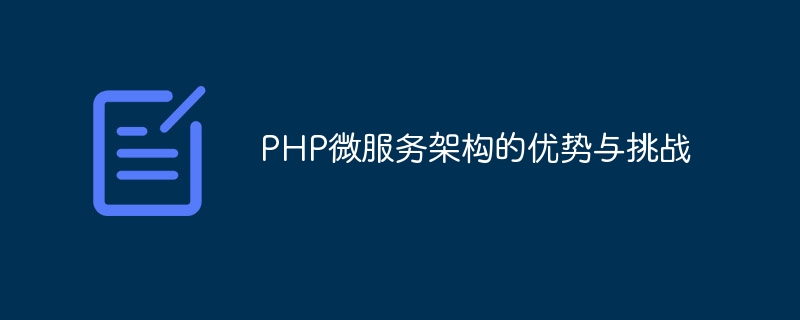

Advantages and Challenges of PHP Microservice Architecture
With the continuous development of Internet technology, microservice architecture has become one of the current hot topics. The microservice architecture achieves better flexibility and maintainability by splitting an application into multiple small services. Each service can be independently deployed and upgraded independently. For PHP developers, how to use the PHP language to build a stable and efficient microservice architecture is a matter of great concern. This article will explore the advantages and challenges of PHP microservice architecture and illustrate it with specific code examples.
1. Advantages of PHP microservice architecture
2. Challenges of PHP microservice architecture
3. Code Example
The following is a simple PHP microservice architecture example to illustrate its advantages and challenges:
Suppose we have an e-commerce system, The demand is split into three microservices: order service, product service and user service. The order service is responsible for processing order-related logic, the product service is responsible for managing product information, and the user service is responsible for managing user information. Each microservice communicates through RESTful API.
Order serviceOrder Service class example:
class OrderService
{
public function createOrder($userId, $productId, $quantity)
{
// 调用用户服务获取用户信息
$userService = new UserService();
$user = $userService->getUserInfo($userId);
// 调用商品服务获取商品信息
$productService = new ProductService();
$product = $productService->getProductInfo($productId);
// 处理订单逻辑
// ...
}
}Commodity serviceCommodity Service class example:
class ProductService
{
public function getProductInfo($productId)
{
// 查询数据库获取商品信息
// ...
}
}User serviceUser Service class example:
class UserService
{
public function getUserInfo($userId)
{
// 查询数据库获取用户信息
// ...
}
}Through the above examples, we can see that the advantage of microservice architecture is that each service has independent responsibilities and functions, making it easy to expand and maintain. However, in actual development, challenges in inter-service communication, data consistency, monitoring and debugging, deployment and operation and maintenance also need to be considered to ensure the stability and reliability of the system.
In summary, although the PHP microservice architecture has some challenges, through reasonable architectural design and technology selection, its advantages can be fully utilized and successful in actual projects. I hope this article will inspire PHP developers in microservice architecture, continue to improve their technical level, and build a more stable and efficient system.
The above is the detailed content of Advantages and challenges of PHP microservice architecture. For more information, please follow other related articles on the PHP Chinese website!
 How to open php file
How to open php file
 The difference between distributed and microservices
The difference between distributed and microservices
 How to remove the first few elements of an array in php
How to remove the first few elements of an array in php
 What to do if php deserialization fails
What to do if php deserialization fails
 How to connect php to mssql database
How to connect php to mssql database
 How to connect php to mssql database
How to connect php to mssql database
 How to upload html
How to upload html
 How to solve garbled characters in PHP
How to solve garbled characters in PHP